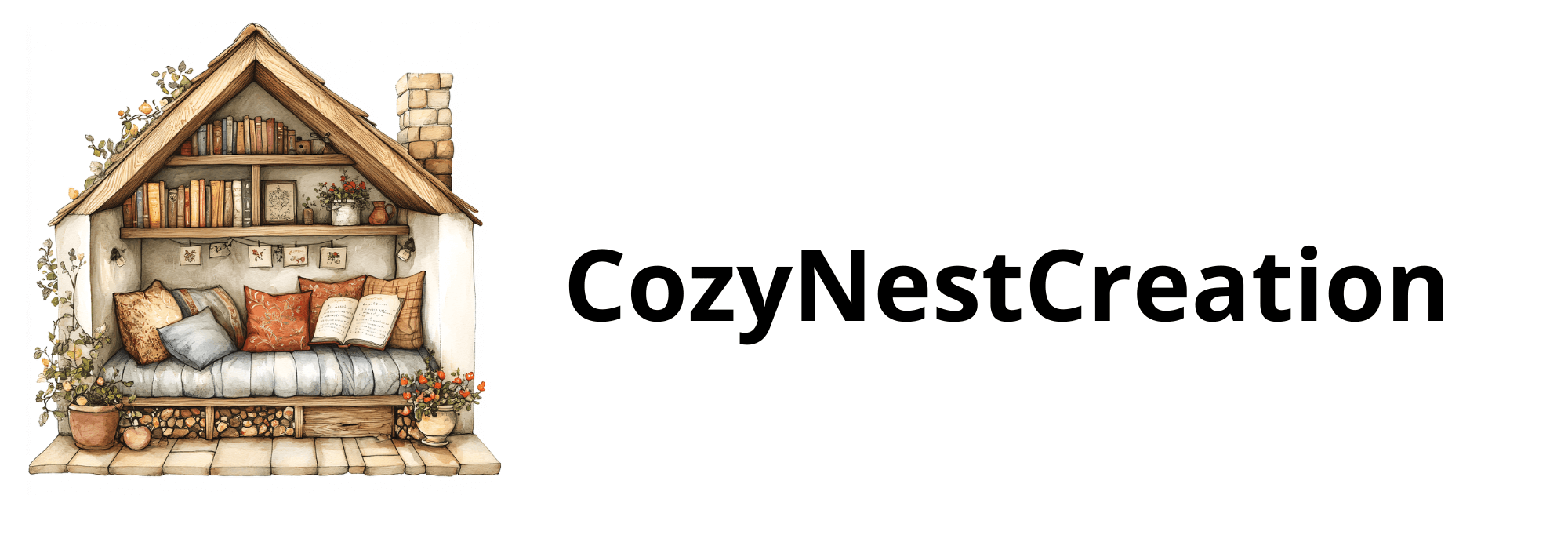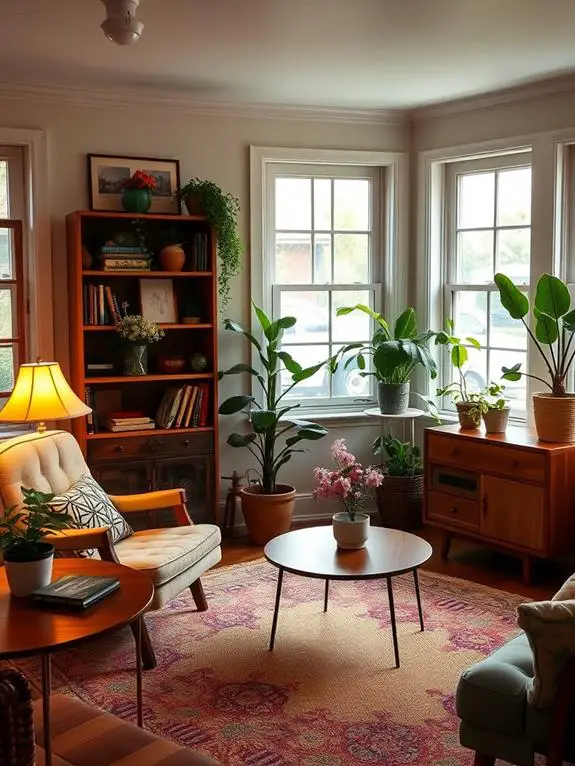Transform your space with secondhand furniture and release your creativity! You'll find hidden gems at thrift stores, where regular visits can uncover unique pieces. Don't be afraid to mix vintage and modern items for a personalized look. Breathe new life into old furniture with a fresh coat of paint or reupholstering. Embrace imperfections and repurpose antiques in unexpected ways, like turning a dresser into a kitchen island. Use a unifying color palette to tie mismatched finds together, and add character with eclectic decor. With a little imagination and elbow grease, you'll create a cozy, one-of-a-kind home that reflects your style. The possibilities are endless when you immerse yourself in the world of secondhand treasures.
Key Takeaways
- Transform secondhand furniture with upcycling techniques like repainting, changing hardware, or reupholstering for a personalized touch.
- Mix vintage and modern pieces to create a unique, balanced space with contrasting styles and textures.
- Use a unifying color palette to tie together mismatched secondhand finds for a cohesive look.
- Repurpose antique items creatively, turning dressers into kitchen islands or vintage suitcases into side tables.
- Incorporate eclectic secondhand decor by pairing vintage textiles with contemporary furniture and mixing various wood tones.
Thrift Store Treasure Hunting Tips
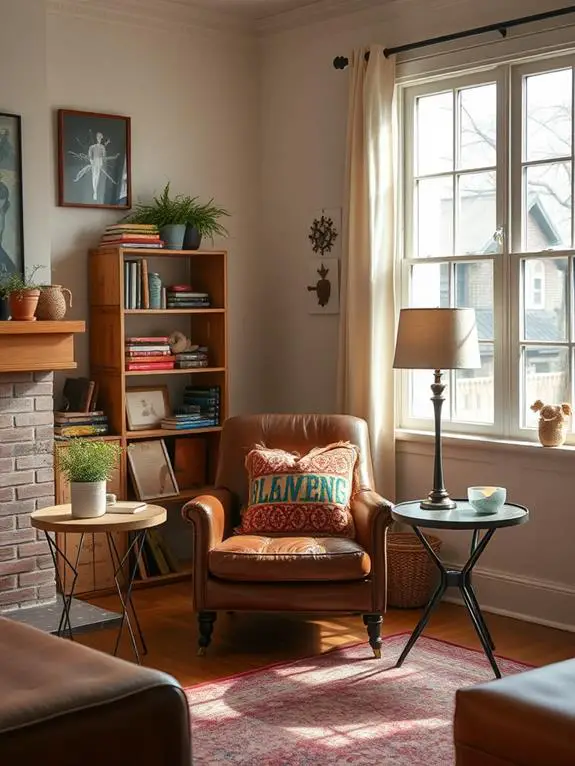
Savvy shoppers know that thrift stores are goldmines for secondhand furniture. To uncover these hidden gems, visit stores regularly and build relationships with staff. They'll often give you the inside scoop on new arrivals. Don't be afraid to look beyond surface imperfections; a little TLC can transform a worn piece into a stunning focal point. Bring a tape measure and fabric swatches to guarantee your finds fit your space and style. Consider incorporating winter decor ideas to give your thrifted furniture a cozy, seasonal touch that can easily be changed throughout the year.
When you spot a potential treasure, examine it thoroughly. Check for sturdy construction, smooth drawer operation, and minimal odors. Trust your instincts – if a piece speaks to you, it's worth considering. Remember, patience is key in thrift store hunting. You might not find the perfect item every time, but when you do, it'll be uniquely yours and full of character.
Upcycling Basics for Beginners
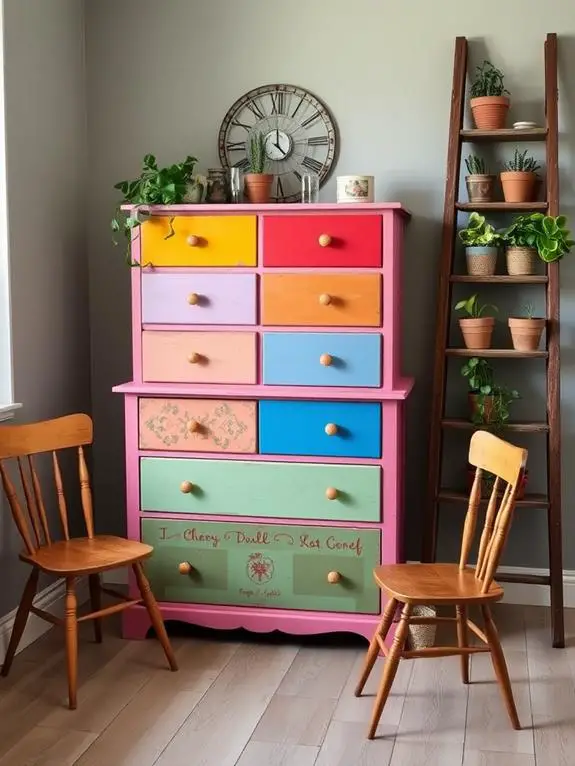
Creativity flourishes when you embrace upcycling, the art of transforming old furniture into fresh, personalized pieces. You'll discover a world of possibilities as you breathe new life into forgotten treasures. Start small with a simple project, like repainting a wooden chair or replacing drawer knobs. As you gain confidence, try your hand at more complex tasks, such as reupholstering a cozy armchair or refinishing a vintage dresser. While exploring upcycling techniques, keep in mind that site improvements may temporarily limit access to online resources, so it's wise to gather information beforehand. Additionally, consider joining local upcycling communities for hands-on support and inspiration during your projects.
Gather essential tools like sandpaper, paint brushes, and a sturdy work surface. Don't forget safety gear – gloves and a mask are must-haves. Before diving in, clean your piece thoroughly and repair any damage. Let your imagination soar as you choose colors, fabrics, or finishes that reflect your unique style. Remember, imperfections add character, so embrace the learning process. Soon, you'll be transforming secondhand finds into stunning focal points for your home.
Mixing Vintage and Modern Pieces
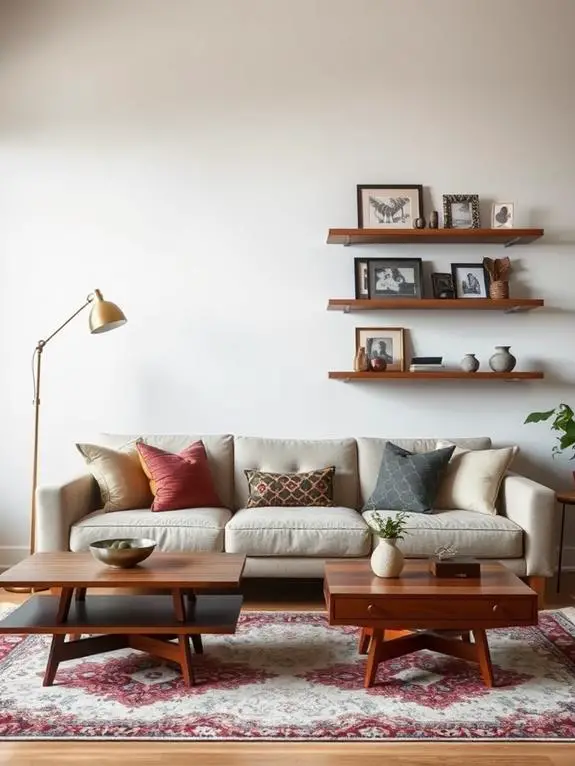
Once you've mastered the basics of upcycling, you're ready to tackle the art of mixing vintage and modern pieces. This exciting blend creates a unique, personalized space that tells your story. Start by choosing a focal point, like a charming antique armoire, and build around it with sleek, contemporary items. The key is balance: pair a mid-century modern sofa with vintage side tables, or place a rustic farmhouse dining table beneath a striking modern chandelier. Don't be afraid to experiment with contrasts in color, texture, and shape. A weathered wooden chest can add warmth to a room filled with crisp, white furniture. This approach can even be applied to outdoor spaces, transforming your balcony with a mix of vintage planters and modern seating options. Remember, the goal is to create harmony, not clash. As you mix eras, you'll discover a delightful interplay between old and new, crafting a space that's both timeless and fresh.
Paint Transformations for Old Furniture
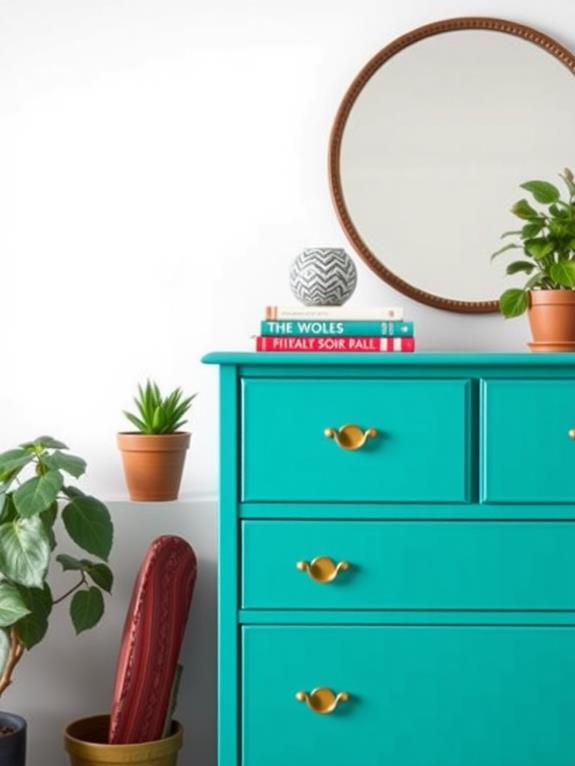
Why settle for drab, outdated furniture when a fresh coat of paint can breathe new life into your secondhand finds? It's amazing how a simple paint job can transform a tired piece into a stunning focal point in your home. Start by choosing a color that complements your existing decor or go bold with a vibrant hue that makes a statement. Before you begin, prep the surface by sanding and cleaning thoroughly. For a smooth finish, apply primer and let it dry completely. Then, brush on your chosen paint in thin, even layers. Don't be afraid to get creative with patterns or ombre effects for added interest. While waiting for paint to dry, you might consider exploring future site updates for more inspiration on home decor. Remember that proper preparation is key to achieving a professional-looking finish. Once dry, protect your masterpiece with a clear sealant. You'll be amazed at how your newly painted treasure adds character and charm to your space, all while saving money and reducing waste.
Reupholstering 101: Fabric Facelift Techniques
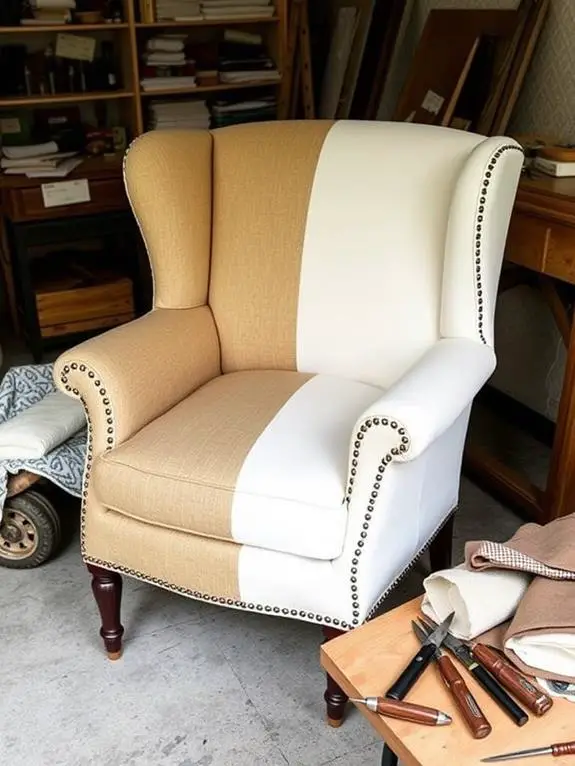
While paint can work wonders, sometimes a piece of furniture needs more than just a color change. That's where reupholstering comes in, giving your beloved secondhand finds a complete fabric facelift. You'll be amazed at how a fresh textile can breathe new life into an old chair or sofa. For a spring garden-inspired look, consider floral patterns or pastel hues that evoke the essence of the season. Start by carefully removing the old fabric, taking notes on how it's attached. Choose a durable, attractive fabric that complements your decor, and don't be afraid to mix patterns or textures. Use a staple gun to secure the new fabric, working from the center outward to avoid wrinkles. For a polished look, add decorative nail heads or piping along the edges. With patience and attention to detail, you'll transform that worn-out piece into a stunning focal point that feels like it was made just for your home.
Repurposing Furniture for New Uses
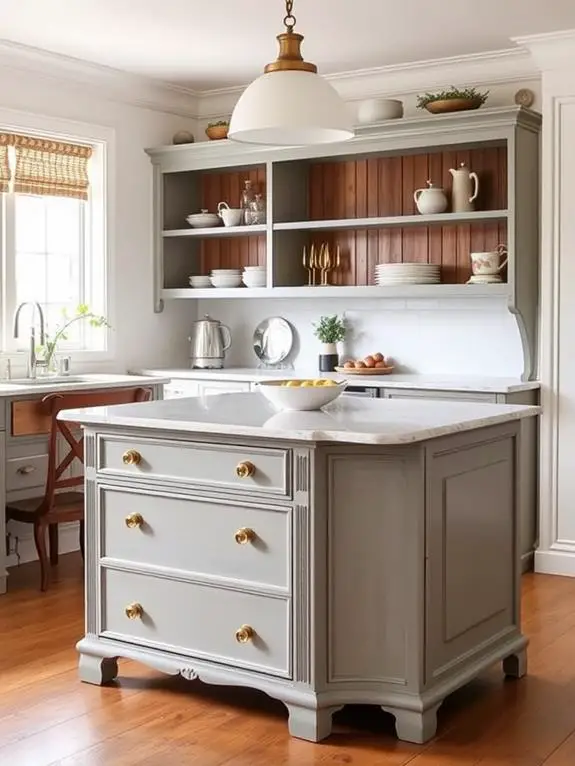
Countless secondhand furniture pieces can find new life through creative repurposing. You'll be amazed at how a simple change in perspective can transform an old dresser into a charming kitchen island or a worn-out ladder into a rustic bookshelf. Let your imagination run wild as you explore the endless possibilities of furniture upcycling. As you embrace autumn, consider incorporating elements of wildlife habitat decor to add a cozy, natural feel to your repurposed pieces.
Consider these inspiring ideas to get you started:
- Turn an antique suitcase into a quirky side table
- Convert a vintage door into a headboard for your bed
- Repurpose an old piano into a unique bar or work desk
- Transform wooden crates into stylish storage cubbies
Styling Mismatched Secondhand Finds
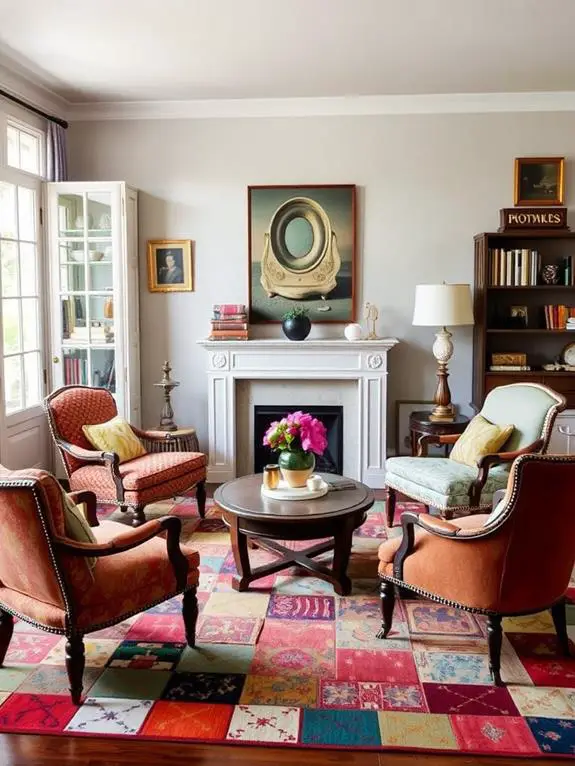
Creating a cohesive look with mismatched secondhand furniture can be both challenging and rewarding. You'll find joy in blending unique pieces to create a space that's truly your own. Start by choosing a unifying color palette that ties your eclectic finds together. Maybe it's the warm tones of walnut and mahogany or the cool hues of painted finishes. Don't be afraid to mix styles – a vintage dresser can look stunning next to a mid-century modern chair. Consider incorporating fall-inspired decor to add a seasonal touch to your secondhand finds. This can create a cozy atmosphere and tie your space together. Use textiles like throw pillows and area rugs to bridge gaps between different pieces. Embrace imperfections; they add character to your space. Group items by function or visual weight to create balance. Remember, the key is to tell your story through carefully curated pieces. With a little creativity and patience, you'll transform your mismatched treasures into a harmonious and inviting home.
Budget-Friendly DIY Furniture Makeovers
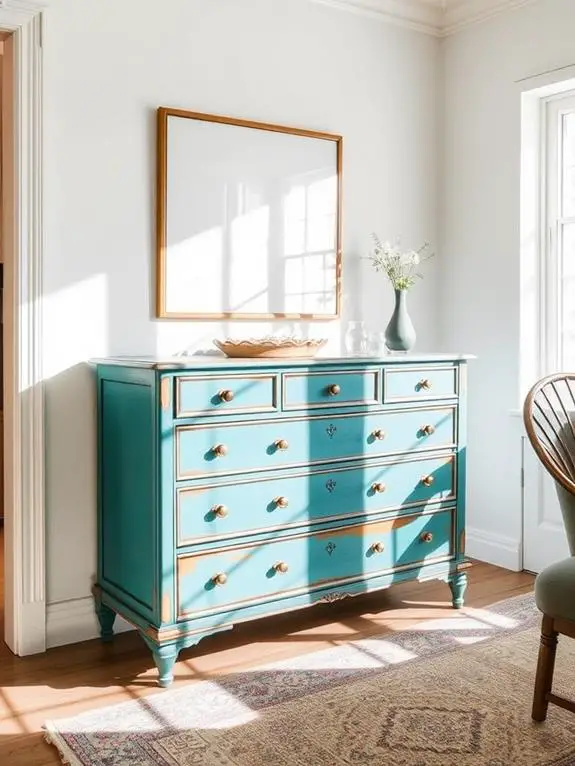
Breathing new life into secondhand furniture doesn't have to break the bank. With a little creativity and elbow grease, you can transform tired pieces into stunning focal points for your home. Imagine the satisfaction of sinking into a beautifully reupholstered armchair or running your fingers along a freshly painted dresser. These budget-friendly makeovers not only save money but also reduce waste and add character to your space.
Try these simple DIY ideas to revamp your secondhand finds:
- Sand and stain wooden furniture for a rustic charm
- Apply a fresh coat of chalk paint for a shabby-chic look
- Decoupage drawer fronts with colorful paper or fabric
- Replace outdated hardware with modern knobs and pulls
Restoring Antique Pieces
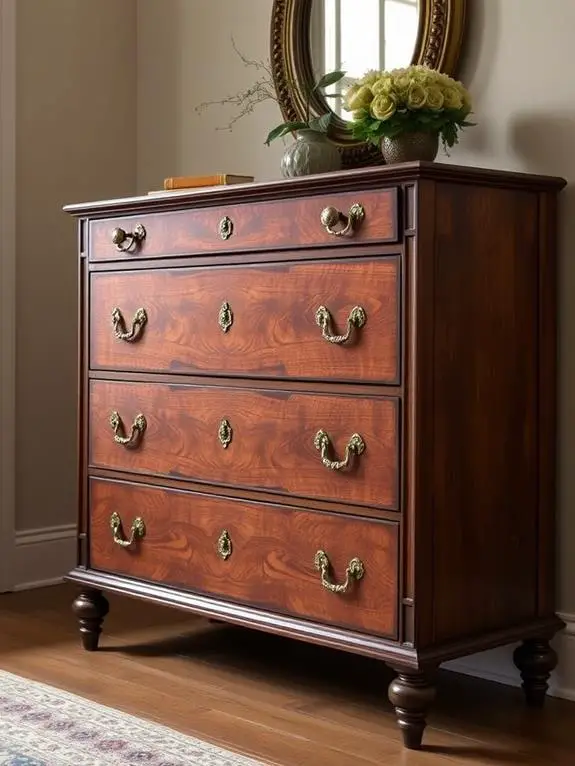
While budget-friendly makeovers can work wonders for many secondhand pieces, antique furniture often requires a more delicate touch. When you're restoring an antique, it's essential to preserve its history and character. Start by gently cleaning the piece with a soft cloth and mild soap, being careful not to damage the patina. Next, assess any repairs needed, such as loose joints or damaged veneer. For minor scratches, try rubbing them with a walnut or using a touch-up pen. If the piece needs refinishing, consider using traditional methods like French polishing to maintain its authenticity. Remember, sometimes less is more – a few small repairs can enhance an antique's charm without erasing its story. As you work, imagine the generations who've cherished this piece before you, and let that inspire your restoration efforts.
Incorporating Eclectic Secondhand Decor
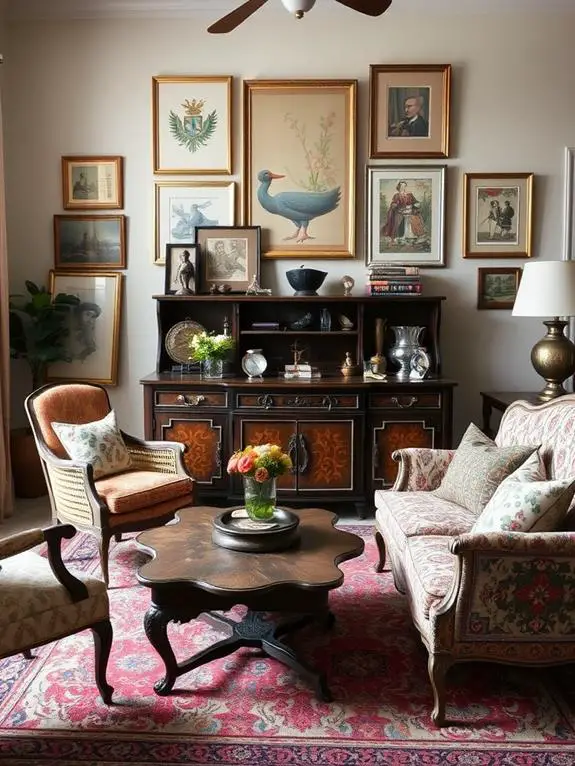
Eclectic decor embraces the unexpected, and secondhand pieces are perfect for achieving this unique style. You'll love how mixing vintage finds with modern elements creates a space that's uniquely you. When hunting for secondhand treasures, keep an open mind and look for pieces that speak to you, regardless of their original purpose.
Here are four ways to incorporate eclectic secondhand decor:
- Mix different wood tones for a rich, layered look
- Pair vintage textiles with sleek, contemporary furniture
- Use antique frames to display modern art or photographs
- Repurpose old industrial items as quirky storage solutions
Don't be afraid to experiment with bold colors and patterns. Your eclectic space should tell a story, so choose pieces that reflect your personality and experiences. Remember, the key to successful eclectic decor is balance – aim for a cohesive look that feels both curated and comfortable.
Frequently Asked Questions
How Do I Identify Valuable Vintage Furniture Pieces When Shopping Secondhand?
When you're hunting for valuable vintage furniture, keep an eye out for quality craftsmanship and unique designs. Look for solid wood construction, dovetail joints, and original hardware. You'll want to check for maker's marks or labels, which can indicate a piece's origin and potential value. Don't shy away from items that need a little TLC – sometimes, the most valuable finds are hidden beneath years of wear. Trust your instincts and do some quick research on your phone while you're shopping to spot those hidden gems.
What Are the Best Online Platforms for Buying and Selling Used Furniture?
You'll find a treasure trove of used furniture online, ready to transform your space. Cozy up to popular platforms like Facebook Marketplace, Craigslist, and eBay for local deals. Explore specialized sites such as Chairish and 1stDibs for unique vintage pieces. Don't overlook AptDeco or Kaiyo for curated selections. Remember, each platform offers its own charm and selection. Whether you're hunting for a comfy armchair or a rustic dining table, these sites will help you discover the perfect pre-loved piece for your home.
How Can I Safely Clean and Disinfect Secondhand Furniture Before Use?
You'll want to start by giving your secondhand furniture a thorough once-over. Vacuum upholstered pieces, then treat them with a fabric sanitizer spray. For wooden or metal surfaces, wipe them down with a mixture of warm water and mild dish soap. Don't forget to disinfect by using a solution of water and white vinegar or a commercial disinfectant. Let everything dry completely before use. Remember, a little elbow grease goes a long way in making your new-to-you furniture fresh and inviting!
Are There Any Secondhand Furniture Items I Should Avoid for Safety Reasons?
When shopping for secondhand furniture, it's best to avoid a few items for safety reasons. You'll want to steer clear of upholstered pieces that might harbor bed bugs or other pests. Be cautious with cribs or children's furniture, as they may not meet current safety standards. Avoid particle board furniture with water damage, as it can be unstable. Finally, be wary of vintage pieces with peeling paint, which could contain lead. Your safety should always come first when furnishing your cozy home.
How Do I Negotiate Prices When Buying Furniture From Individual Sellers?
When you're negotiating with individual furniture sellers, start by doing your homework. Research fair prices for similar items and use that as your baseline. Be friendly and show genuine interest in the piece. Don't be afraid to make a reasonable offer, but be prepared to walk away if needed. Remember, cash in hand can be persuasive. If you're buying multiple items, ask for a bundle discount. Always inspect the furniture carefully before sealing the deal.
